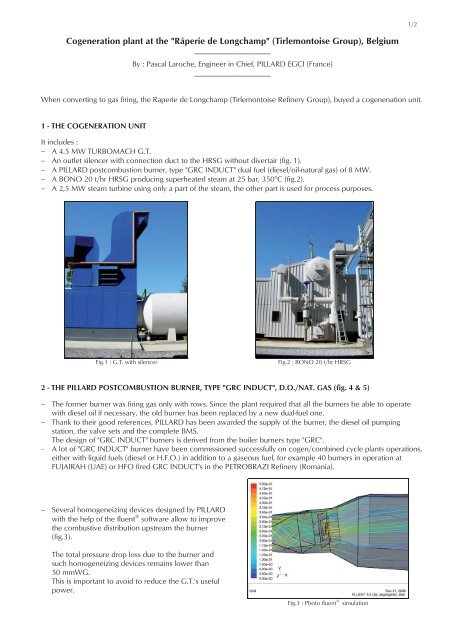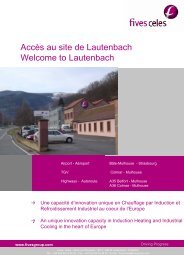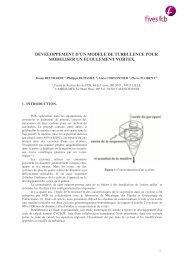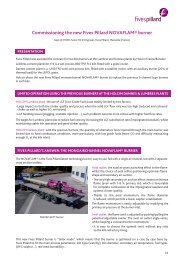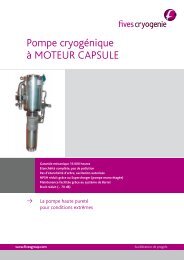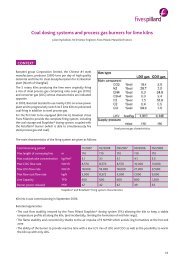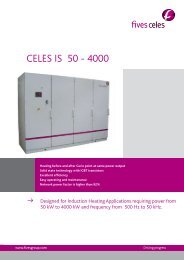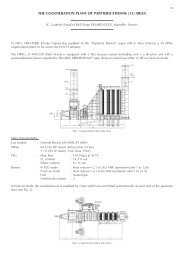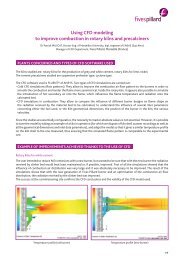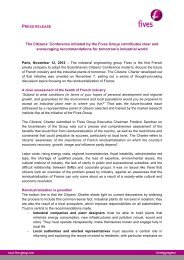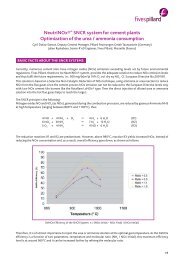"Râperie de Longchamp" (Tirlemontoise Group), Belgium - Fives
"Râperie de Longchamp" (Tirlemontoise Group), Belgium - Fives
"Râperie de Longchamp" (Tirlemontoise Group), Belgium - Fives
You also want an ePaper? Increase the reach of your titles
YUMPU automatically turns print PDFs into web optimized ePapers that Google loves.
1/2<br />
Cogeneration plant at the "Râperie <strong>de</strong> Longchamp" (<strong>Tirlemontoise</strong> <strong>Group</strong>), <strong>Belgium</strong><br />
____________________<br />
By : Pascal Laroche, Engineer in Chief, PILLARD EGCI (France)<br />
____________________<br />
When converting to gas firing, the Raperie <strong>de</strong> Longchamp (<strong>Tirlemontoise</strong> Refinery <strong>Group</strong>), buyed a cogenenation unit.<br />
1 - THE COGENERATION UNIT<br />
It inclu<strong>de</strong>s :<br />
A 4.5 MW TURBOMACH G.T.<br />
An outlet silencer with connection duct to the HRSG without divertair (fig. 1).<br />
A PILLARD postcombustion burner, type "GRC INDUCT" dual fuel (diesel/oil-natural gas) of 8 MW.<br />
A BONO 20 t/hr HRSG producing superheated steam at 25 bar, 350°C (fig.2).<br />
A 2,5 MW steam turbine using only a part of the steam, the other part is used for process purposes.<br />
Fig.1 : G.T. with silencer<br />
Fig.2 : BONO 20 t/hr HRSG<br />
2 - THE PILLARD POSTCOMBUSTION BURNER, TYPE "GRC INDUCT", D.O./NAT. GAS (fig. 4 & 5)<br />
The former burner was firing gas only with rows. Since the plant required that all the burners be able to operate<br />
with diesel oil if necessary, the old burner has been replaced by a new dual-fuel one.<br />
Thank to their good references, PILLARD has been awar<strong>de</strong>d the supply of the burner, the diesel oil pumping<br />
station, the valve sets and the complete BMS.<br />
The <strong>de</strong>sign of "GRC INDUCT" burners is <strong>de</strong>rived from the boiler burners type "GRC".<br />
A lot of "GRC INDUCT" burner have been commissioned successfully on cogen/combined cycle plants operations,<br />
either with liquid fuels (diesel or H.F.O.) in addition to a gaseous fuel, for example 40 burners in operation at<br />
FUJAIRAH (UAE) or HFO fired GRC INDUCT's in the PETROBRAZI Refinery (Romania).<br />
Several homogeneizing <strong>de</strong>vices <strong>de</strong>signed by PILLARD<br />
with the help of the fluent software allow to improve<br />
the combustive distribution upstream the burner<br />
(fig.3).<br />
The total pressure drop loss due to the burner and<br />
such homogeneizing <strong>de</strong>vices remains lower than<br />
50 mmWG.<br />
This is important to avoid to reduce the G.T.'s useful<br />
power.<br />
Fig.3 : Photo fluent simulation
2/2<br />
Fig.4 : PILLARD burner type "GRC INDUCT"<br />
seen from insi<strong>de</strong> the duct<br />
Fig.5 : External view of the burner<br />
The burner is equipped with a PILLARD ignitor of the last generation type "PACKLIGHT" operating either on natural<br />
gas or on propane, and which concentrates in its back head all components including the HT transformer and the<br />
self checking ionization <strong>de</strong>tector PILLARD type "IONY". This allows to simplify all the electric connections as well<br />
as maintenance.<br />
The flame <strong>de</strong>tectors have been doubled in or<strong>de</strong>r to increase the operational availability. Also of the last generation<br />
of PILLARD <strong>de</strong>tectors -type PACKSCAN-, all their components are lodged in the scanner head (without separate<br />
box) and they benefit from very exten<strong>de</strong>d adjustment possibilities.<br />
The diesel oil atomisation is achieved thanks to a PILLARD gun type ZV2 and assisted by compressed air (steam<br />
should be possible un<strong>de</strong>r <strong>de</strong>mand).<br />
In spite of the high pressure insi<strong>de</strong> the TEG duct, it is possible to remove the burner gun for maintenance in totally<br />
safe conditions without stopping the GT thanks to a double closing system.<br />
The diesel oil pumping set and the gas/diesel oil valve set (fig. 6) used to shut-off and control the fuels flows is prewired<br />
with junction box.<br />
The BMS including an Allen Bradley PLC (see fig.7) and a programmable regulator manages the sequences and<br />
safeties as well as the fuel flow control in or<strong>de</strong>r to maintain constant the HRSG's steam pressure.<br />
Fig.6 : D.O. pumping set and gas/D.O. valve set<br />
Fig.7 : View of the BMS<br />
3 - CONCLUSION<br />
The commissioning has been successfully completed second half of 2005. All guaranteed performances have been<br />
reached.<br />
The good operational availability of the postcombustion system allowed to operate continuously during all the Sugar<br />
campaign.


